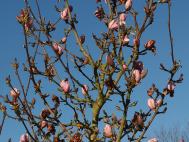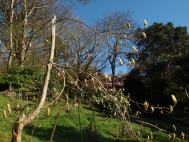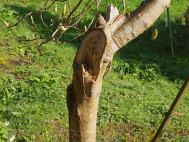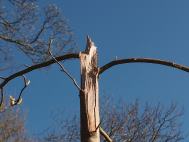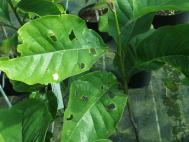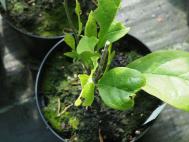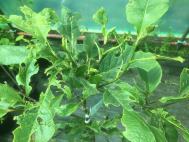- Shop Now
- Burncoose Specialities
- This Month
- Offers & Promotions
- RHS Chelsea Flower Show 2024
- 40 years at Burncoose
- Engage With Us
- Information, Help & Advice
- About Us & Our Services
- Terms & Conditions
- Log In / Register
Chapters
- Cultivation of Magnolias
- Pruning Magnolias - Video Tip
- Pruning shoots on grafted rootstock - Video Tip
- Pruning small & large shoots below the graft - Video Tip
- Pruning & Shaping Magnolia - Video Tip
- Soil Conditions
- Planting Locations
- Planting a magnolia - Video Tip
- Secondary Flowering - Video Tip
- Scraping deadwood to see if alive - Video Tip
- Pests and Diseases
- Magnolia Slug Protection - Short Video Tip
- Slug Protection - Longer Video Tip
- Removing Ivy - Video Tip
- Scale Insect on Magnolias - Video Tip
- Further Reading
- Plants
Magnolia - Care Guide
Cultivation of Magnolias
Magnolias are easy to grow and relatively pest free. Once established they need the minimum of attention.
The perceived problems of size, first flowering and frost damage – Magnolia myths.
The three things which most frighten people about magnolias is firstly their ultimate height as tall trees, secondly the length of time which they take to produce their first flowers and finally the susceptibility of the early flowers to frost.
Although the 80-100 feet tall Magnolia campbellii, sargentiana robusta and mollicomatas which produce such a spectacle in February and March in Cornish woodland gardens can appear a bit daunting it must be remembered that magnolias grow much taller in Cornwall than they will in other parts of the country where rainfall is much less. There are several species which are smallish shrubs and which are entirely suitable for smaller gardens or even tub growing (e.g. Magnolia stellata, M. lilliflora Nigra and several crosses between these two species - ‘Susan’, ‘Randy’, ‘Ricky’ and ‘Jane’). Most varieties of Magnolia soulangeana are excellent garden plants which will become large shrubs but can readily be pruned. Not all magnolia species and varieties are therefore just the preserve of large country gardens although tree magnolias should clearly not be grown too near houses.
If you grow tree magnolias from seed they may well take 10-15 years until they first flower. In one instance at Caerhays a magnolia took over 40 years to flower. However, most magnolias sold today are GRAFTED plants. This means that the long wait until first flowering can be readily avoided because of scion material used to make the graft comes from the flowering tips and branches of existing plants. Some grafted tree magnolias will even flower while still in their pots but it would be very bad luck for a grafted plant not to be flowering away within 3-5 years from planting. This criticism of magnolias is also therefore a misconception.
Clearly any plant which comes into flower in February or March runs a very real risk of having its flowers frosted. Even in the mild Cornish climate this can and will happen some years. However magnolias adapt to the climate of their surroundings and a Magnolia campbellii in Yorkshire might only come into flower in April in a cold spring. Certainly it might well still get frosted but it is not necessarily going to happen very often.
If you live in a frost pocket or in the North of England or Scotland you need to select magnolias which do not flower until mid April and mid May. There are plenty of taller growing magnolias to choose from and ‘Serene’, ‘Iolanthe’, ‘Caerhays Surprise’, ‘Atlas’ or ‘Apollo’ are all good choices. Additionally most Magnolia Soulangeana hybrids do not come out until May.
So select the variety for your area and stop worrying too much. If our current run of very mild winters continue the risk of frost damage is minimal and magnolia flower buds are very well protected by two furry outer coatings which only drop as the bud opens.
Just because the flowers can occasionally get caught by frost does not mean that magnolia trees and shrubs are not totally hardy. They most definitely are so put these three popular myths behind you and treat them as the uninformed misconceptions that they are.
Pruning Magnolias - Video Tip
Pruning dieback
Pruning shoots on grafted rootstock - Video Tip
Pruning small & large shoots below the graft - Video Tip
Pruning & Shaping Magnolia - Video Tip
Soil Conditions
A slightly acidic soil is best. Lime or alkaline soils are more difficult for magnolias but, while nothing will grow on pure chalk, many Magnolia stellata and Magnolia soulangeana varieties grow perfectly well on ph’s of 7 as opposed to the optimum 5.5 – 6.5. If you look at the magnolia collection in Windsor Great Park and in the Savill Gardens it is hardly an acidic soil area but with the application of peat and fertiliser you would not know it.
Planting Locations
Although, as explained, magnolia trees and shrubs are totally hardy it is foolish to plant them in windy or exposed areas where not just the flowers but also their large leaves can get damaged unnecessarily. Magnolias hold their leaves long into autumn which accounts for their phenomenal growth rates. However it makes the trees vulnerable to heavily leafed branches literally splitting off or breaking in strong winds. Some shelter is therefore advisable.
Planting a magnolia - Video Tip
Secondary Flowering - Video Tip
Secondary Flowering in August
Secondary Flowering in September
Scraping deadwood to see if alive - Video Tip
In spring you may find your magnolia looks dead, by scraping the bark you will be able to tell if it has died during the winter cold.
Pests and Diseases
Magnolias are relatively pest and disease free in comparison to say rhododendrons. However, as usual in nature, there are a few things you can do to avoid disasters. The majority of magnolia casualties soon after planting can be attributed to one of the following problems:-
- Biggest Problem 1 - When you plant a grafted magnolia the old soil level in the pot must marry up and be level with the soil level in the ground. If you bury the rootball or potfull more deeply you will very probably end up covering the graft with soil. This will soon cause the graft to become infected and the plant will die even if the rootball survives. You can easily achieve the same result by mulching too thickly and again covering up the graft. We have an article on how to plant a tree if you need more help.
- Biggest Problem 2 - Very often we are told that a customer’s magnolia has come into leaf and then suddenly the leaves have vanished or gone brown or have turned into leaf skeletons. This is the work of small slugs which live in the soil and only emerge in damp weather usually overnight to take their fill of young magnolia shoots and leaves. Snails may help out too but you seldom actually see them at work. Prevention is possible but in extreme cases there is no cure after the event. In April and May as the leaves unfurl you should add slugbait to the base of the plant and repeat this after rain for a couple of weeks until the leaves are fully formed. After 2 or 3 years of growth the plants can usually withstand a slug attack but not before their root systems have formed properly.
- Biggest Problem 3 - The sap in magnolia stems and bark is highly pungent and therefore especially attractive to rabbits. If you planted out 10 trees only one of which was a magnolia, it is a near certainty that the magnolia will get ring barked by rabbits first. You may say that you do not have a rabbit problem but it only takes one! The solution is to put a spiral guard around the main stem but some magnolias have lots of side shoots which makes this difficult. Better still is to make up a circle of 1 inch wire netting which is at least 2 1/2 feet tall and surround the plant with this. This will afford genuine rabbit protection. Happily deer do not seem to like magnolias as much as rabbits at least with us.
Magnolia Slug Protection - Short Video Tip
Slug Protection - Longer Video Tip
Removing Ivy - Video Tip
Scale Insect on Magnolias - Video Tip
Further Reading
How to move an established shrub
How to collect, store and plant woody shrub and tree seeds
Further reading on the Caerhays website:-
The National Collection of Magnolias at Caerhays Castle
Magnolias raised and bred at Caerhays and Burncoose
The history and breeding of Yellow Magnolias
Newest Magnolia Hybrids - 2021
Further reading and images in the Caerhays Garden Diary - Magnolias






